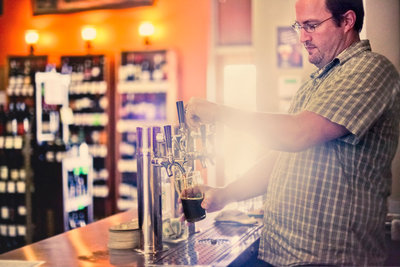
While tap lists at local bars and breweries seem to range from elusive to overwhelming with not much in between, choosing a beer can be a daunting task. With new craft creations, a multitude of IPAs vying for attention and beer pairing taking a seat at the table, it’s an intimidating, brave new world.
So if you’re new to the brewery scene and playing catch up on the craft beer revolution, EW is bringing you the basics with Mike Coplin of 16 Tons Taphouse as our cicerone (aka a beer sommelier).
If you’re thinking of embarking on the beer scene this weekend with a couple of friends, walk boldly up to the bar and ask for a sample of what is on tap. Samples are usually free, and the bartender can help narrow down what you do and don’t like, bringing you closer to picking that perfect pint.
“Sampling is absolutely crucial, so you can say ‘Well, I like this,’ and have a point of reference,” Coplin says. “If you like that, awesome, because then there’s like 500 other beers you’ll probably like.”
Light lagers are the most popular beer in the United States and almost every other country in the world due to their clean finish, beautiful color and crisp flavors. “If you like Budweiser or Coors Light, it’s almost 100 percent guaranteed you are going to like a craft beer, you just have to find the right one,” Coplin says. Personally he prefers Pilsners, pale gold lagers named for Pizen (Pilsen), Czech Republic, where this light type of lager, with its balanced flavor of crisp tartness and floral or citrus notes, originated.
Coplin believes recommending beer is hard because it depends on personal taste. “You have no idea until you actually taste it and everybody’s taste is different; it’s one of the most subjective things in the world,” Coplin says. “A lot of people don’t have very developed palettes but love coffee. If you love coffee, then you’re probably going to love stout because stout tastes like coffee. But that’s an easy one.”
Misconceptions of lightness or darkness determining flavor have led some beer drinkers to fear beer they can’t see through. “That’s why I really recommend tasting, because it cuts through all the bullshit, all the strict styles and, ‘Oh I don’t like dark beer,’” Coplin says. He explains that roasted barley determines the coloring, which is why some dark stouts have a roasted coffee flavor.
You can’t go wrong with a shandy, a popular summer drink most often made by mixing a lager with citrus juice. “Anyone who doesn’t like it is just a party pooper,” Coplin says. “It’s like not liking lemonade, or sunshine, or smiles or grass.”
Now if you’ve ever gone for the bad boy, then you’ll understand the attractiveness of an IPA. India Pale Ales come from the 18th century, when English sailors traveled to India with pale ales preserved by extra hops. Not only did the pale ale make it to India, but it arrived with a tart, bold punch of flavor. They’re known for their in-your-face bitterness, but in a hurt-so-good kind of way.
“People who don’t like IPAs, probably just haven’t tried the right IPA,” Coplin explains, because IPAs can taste like anything from pine trees to orange juice.
When you approach the bar this weekend, if everything falls out of your head, one thing to remember is that the game of craft beers doesn’t come with a lot of hard-and-fast rules. At the end of the day, you can’t really mess it up. Take Coplin’s advice: “Do what you want to do. Taste beer and like what you want to like. One of the awesome things about beer is that there are not a lot of rules.”